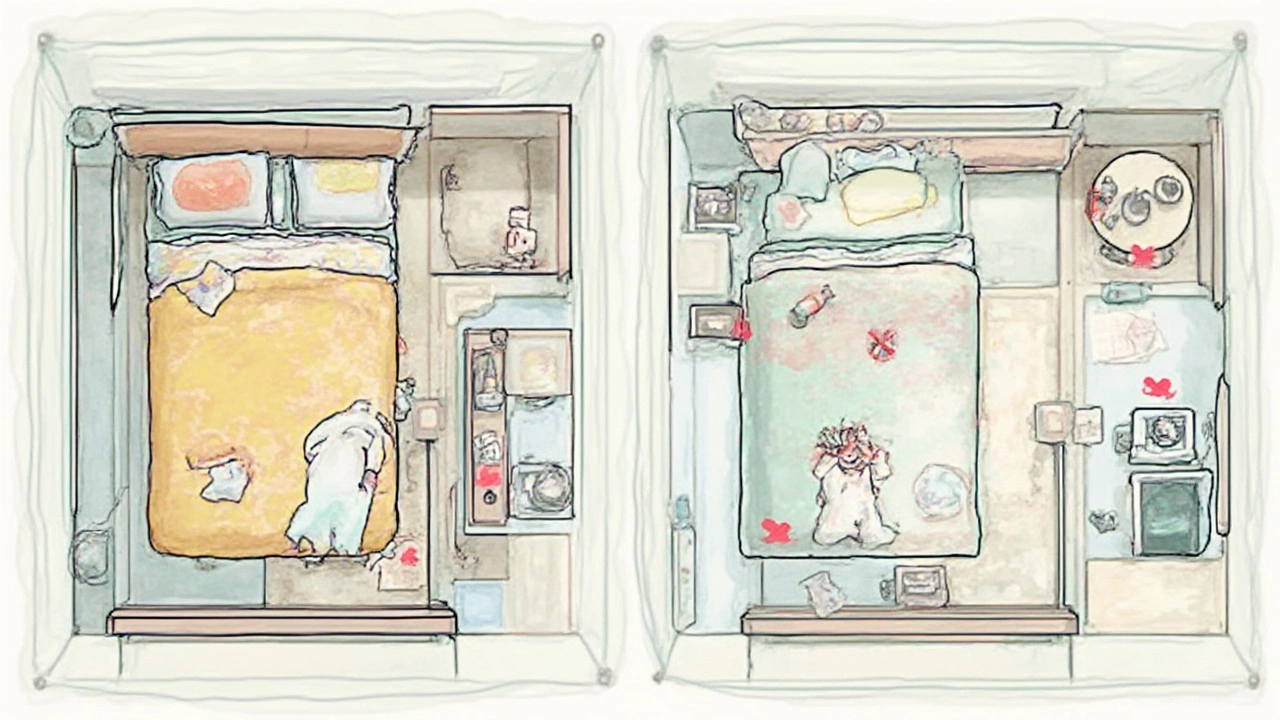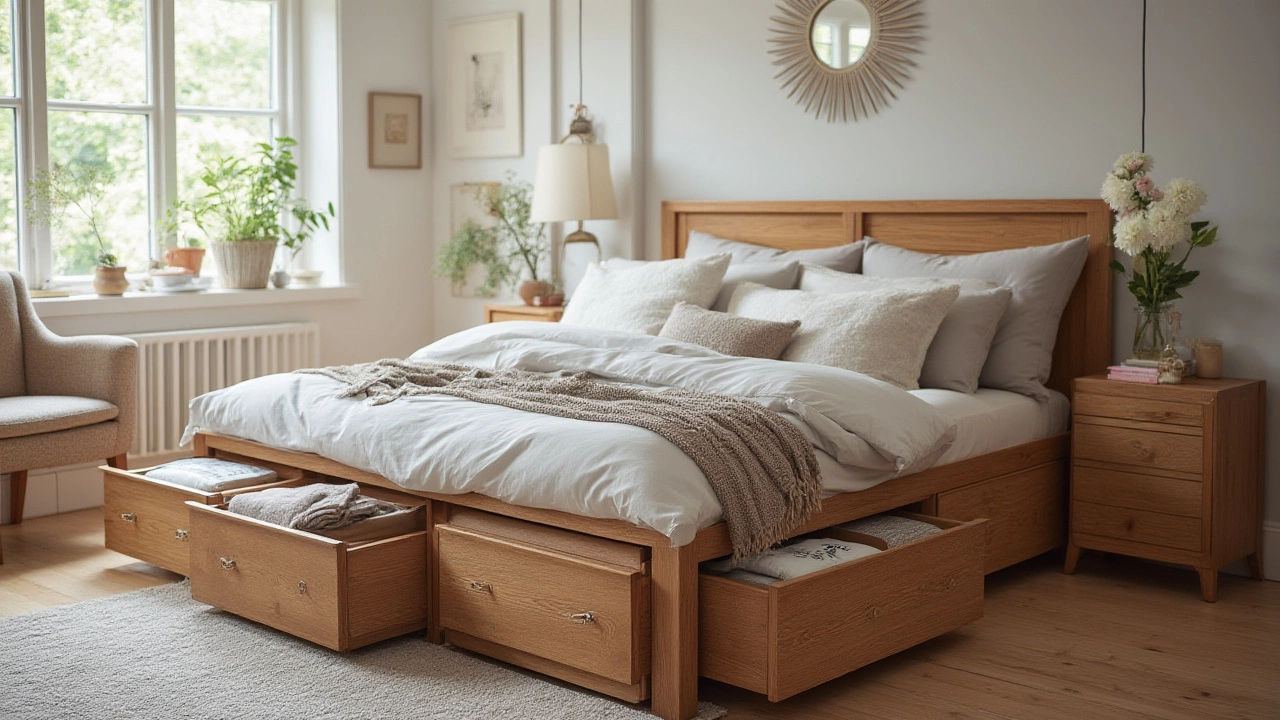If you’ve ever lifted up your mattress to reveal those hidden drawers, you know—storage beds can feel like secret treasure chests. But pack them wrong, and suddenly it’s a pirate’s curse on your stuff. Think it’s fine to stick anything under there? Not so fast. People ruin clothes, attract pests, or even end up with mildew and mystery odors that seep into the whole room—sometimes, those hidden disasters only show themselves after months or years. So, before you toss just anything into your storage bed, let’s unpack what should really stay out and why.
Why Storage Beds Aren’t Universal Dump Zones
It’s tempting to treat the space under your mattress like an out-of-sight, out-of-mind zone. But here’s the catch: a storage bed isn’t a magic vault shielding belongings from every problem. The area is often poorly ventilated. Warmth from the mattress and your body creates a cozy, sometimes humid microclimate that’s perfect for some things (extra blankets) and truly terrible for others (think electronics, expensive heirlooms, or food). Stowing the wrong items can damage your possessions and even shorten your bed’s life.
Some people treat a storage bed like a garage—only smaller. But garages usually get ventilation; storage beds rarely do. Those drawers or open spaces can trap heat and moisture. A study from the Sleep Foundation found that humidity under beds runs up to 15% higher than the ambient bedroom air. With no airflow, textiles soak up moisture, creating the ideal breeding ground for mold, mildew, and bugs. And while it’s rare, trapped moisture can actually cause rust on metal frames or fittings over time. So before you stash something sensitive, ask yourself: would I leave this inside a warm, slightly damp wooden box for months?
You want to avoid anything that could rot, warp, leak, corrode, or attract pests. Even in dry climates, dust builds up fast—especially under beds, where cleaning is rare. Soft items like sweaters might be fine for a season, but what happens if you forget them for a year or two? Moth larvae and carpet beetles are real threats. The same goes for sentimental items like photo albums or paper records—over time, they can yellow, curl, or even disintegrate. Storage beds are best for items you use regularly or rotate with the seasons, not lifelong keepsakes or stuff you’d hate to lose.
If we zoom out a bit, it’s clear why being picky matters. Have you ever heard horror stories of bed bugs hitching a ride in stored bedding, or mice sneaking into those dark nooks? These aren’t just urban legends. According to a 2023 survey by Apartment Therapy, about 18% of respondents said underbed storage became a pest magnet at least once. A storage bed should work for you—not double as an accidental critter condo.
The real trick is being strategic. Use the space, but don’t abuse it. Start by understanding the types of items that simply don’t belong, for either hygiene or preservation reasons. And always remember the golden rule: If you want it to stay fresh, dry, and bug-free, treat your storage as carefully as you treat your closet—not your garage or basement.
Items That Should Never Go in a Storage Bed
If you value your stuff and want to avoid smelly mishaps, steer clear of the usual “do not store” list. First up: anything with sentimental or irreplaceable value. That includes old diaries, birth certificates, diplomas, or those family photo albums from decades ago. The humidity, occasional spills, or even a forgotten cup of tea could mean disaster (yes, it happens). Besides, paper disintegrates much faster in poor conditions—even inside ‘safe’ drawers.
This brings us to electronics. Storage beds are hotspots for trapped heat, so laptops, tablets, old phones, or chargers should stay far away. Lithium batteries stored at high temperatures lose life fast, and at worst, you could risk an electrical fire. And speakers, headphones, gaming consoles? Bad idea—their parts can corrode or pick up moisture from the air faster than you’d imagine.
Let’s talk clothes. Seasonal storage is fine for things like jeans or coats, but avoid delicate fabrics—especially silk and cashmere—or any garment that’s not squeaky clean. Even tiny bits of sweat or food can draw in moths and bugs. If you’re set on storing clothes, vacuum-sealed bags are your friend; they reduce air, which cuts down on both bugs and moisture.
Food should never, ever make its way under your bed. No granola bars. No midnight snack stashes. Not even sealed boxes. The reason? Crumbs and odors lure pests. Mice, ants, and roaches are all famously good at sniffing out forgotten food, and once they move in, getting rid of them can be tough (and costly).
Liquids are out, obviously. Water bottles, perfumes, nail polish remover, and even creams or lotions can leak. With no airflow to dry things out, a small leak can go unnoticed and create big stains or odors. Plus, most storage-bed surfaces are tough to clean after liquid damage—you may end up replacing linings or even wood panels.
Other predictably bad fits? Heavy items or sharp objects. Think dumbbells, tool kits, scissors, or barbecue knives. These can warp the bottom of drawers, scratch wood, or even poke through linings—and if you forget about them, you’re risking stubbed toes or pinched fingers on laundry day. And one more: plants. They need light and air, none of which they get stashed away under your mattress—rip in peace, spider plant.
- Sentimental documents and photos (risk of moisture, crumpling, fading)
- Electronics and anything battery-powered (overheating, corrosion)
- Delicate or expensive clothing (fabric damage, pests)
- Food or snacks (pests, rot, odor)
- Liquids and anything with a risk of leaking (spills, stains, mold growth)
- Heavy, sharp, or oddly shaped items (drawer damage, injury risk)
- Plants (lack of airflow and sunlight)
The warning signs are real. Not every horror story makes it to TikTok, but you’d be surprised how many people have ruined their favorite winter jackets or lost cherished letters because they didn’t think twice about what went under their mattress. Don’t join that club.

What about Moisture and Pest Risks?
If there’s a single biggest enemy of under-bed storage, it’s moisture. And it sneaks up in ways you don’t expect. Heat from your body and the mattress itself can bump up the temperature underneath, while even occasional spills—like a water bottle that tips over in the night—can slowly soak into wood or particleboard. A 2022 interior design report from Good Housekeeping revealed that nearly 30% of storage-bed owners found some signs of moisture or mold after less than a year of use.
Mold is a sneaky one. It doesn’t grow just anywhere, but under the bed, things can get sticky. If you store shoes, old textbooks, bags, or coats without making sure they’re bone-dry, you’re inviting mildew colonies. Once mold gets in, it’s stubborn—often impossible to fully erase from porous surfaces. Plus, the musty odor can spread to everything else that shares the drawer.
Pests are a whole other problem. Your storage bed is warm, dark, and rarely disturbed; to bugs, it’s paradise. Besides the obvious moths and beetles, you might find spiders, silverfish, or even mice turning stored blankets or clothes into nests. Pests don’t just mess with your stuff—they leave droppings, shed skins, and can even chew through fabric or wood. If you’re unlucky, a full infestation can mean replacing the whole bed frame and fumigating your room.
There’s also the dust angle. Dust mites thrive in humid, tucked-away spaces like under mattresses. If you have allergies, filling the storage area with soft furnishings or forgotten linens quickly makes things worse. Even if you vacuum regularly, getting deep inside drawers or corners is tough—so you’re often trapping allergens right below where you sleep.
Of course, this doesn’t mean you can never use your storage bed. You just have to be careful about prepping your items. Always make sure whatever you store is dry and clean. Some people swear by using silica gel packets or small moisture absorbers in each drawer—a little insurance against humidity spikes. For pest control, there are cedar blocks or lavender sachets that help keep moths and beetles at bay.
Many people also try to rotate items every few months to spot problems early. If you keep your storage organized—not just stuff crammed everywhere—you can spot suspicious stains or frauds early, before they get out of hand. And if you live in a humid climate or have no air conditioning, consider using storage beds only for things you’d be okay to lose or wash regularly. A little caution goes a long way if you want your stuff to stay safe.
Best Practices for Safe Storage in a Storage Bed
Using a storage bed doesn’t have to be risky. In fact, with the right approach, you can maximize your space and avoid most of the pitfalls. Start by cleaning out the storage space every couple of months. Wipe down drawers or containers with a dry (never damp) cloth. If you spot any moisture or odd smells, leave the drawer open for a few hours or even overnight so things can air out.
It’s a good idea to use sealed bins or storage bags for anything soft or valuable. This adds a barrier to moisture, keeps bugs out, and makes it a whole lot easier to pull items in and out. Transparent bins are especially handy since you can see what’s inside without digging and rummaging. For shoes or boots, go with hard-sided containers—shoes left loose can get scuffed, squashed, or moldy from trapped sweat.
If you’re storing clothes, make sure they’re freshly washed and totally dried—even a little dampness is risky. Those vacuum-bag systems you see on TV? They aren’t a gimmick: people really find them helpful for keeping things compact, bug-free, and clean. If you prefer to skip plastic, opt for cotton storage bags or bins lined with unbleached muslin—that way, air can circulate while still filtering dust.
Labeling matters more than you think. Since most storage beds are low to the ground, you’ll want to avoid crawling and digging around every time you need something. Masking tape and a marker do the trick; there’s no need for fancy labels. Just tag what’s inside so you can grab it quickly.
And as for pests, be proactive. If you live in an area where bugs or mice are common, check around the rim and closure of drawers for any gaps. Even small cracks are enough for critters to squeeze through—if you spot “frass” (tiny brown bug droppings) or gnawed corners, act fast. Traps, cedar blocks, or essential oil sachets can help. And if you see signs of mold or an infestation, empty the bed right away and repair it before restocking it with anything new.
Some quick-fire do’s and don’ts:
- Do store off-season bedding, towels, or sturdy clothes (as long as they’re dry and clean).
- Don’t store valuables, electronics, delicate fabrics, food, or liquids.
- Do use sealed bins or vacuum bags for extra protection.
- Don’t overload drawers, as this can warp them or break runners.
- Do put in moisture absorbers if you live in a humid climate or notice condensation.
Better storage means fewer surprises. Treat your under-bed space as valuable real estate—because if you’re careful, it definitely can be.

Smart Alternatives and Creative Uses for Storage Beds
If you want to make the most of your storage bed without running risks, think outside the box. Keep everyday essentials and rotating seasonal items handy—think extra throws, bulk packs of socks, or winter hats and gloves. For kids, storage beds are a lifesaver for keeping toys, coloring books, or extra bedding out of sight but within reach.
Another smart hack? Use soft-sided organizers. These fit into storage-bed drawers, dividing the space into segments and keeping everything neat. Rolling storage bags are great if you pull out items often; just slide the whole bag in and out. Some people even use repurposed shoeboxes or small plastic caddies to keep socks and underwear sorted, which makes swapping out items super quick.
Crafters and hobbyists can use the space for project kits, yarn, or fabric as long as it’s packed in airtight bins. Love reading? Keep your in-progress paperbacks in a closed tote (not stacked loose to prevent warping). Gamers with board games or card decks can stow them safely in plastic boxes with silica packs, away from dust and spills.
If you want to really level up, consider built-in lighting. Battery-powered stick-on LED lights make finding things in a deep drawer a snap and save plenty of time hunting around in the dark. Some tech lovers even add Bluetooth trackers to bins or baskets so they don’t forget what’s inside or lose the key to their hidden storage.
But remember, don’t use the space as a crutch for hoarding. It’s best for items you want, need, and use regularly—not as a dumping ground for things you’ll forget or never use again. When you cycle through your storage every season, you avoid surprises and keep the area from becoming a graveyard of lost possessions. Plus, you never have to play the “Where did I put that?” game in a panic.
So next time you eye that empty drawer under your bed and wonder what else you could hide away, think twice about what you stash—and how you store it. Use the space smartly, and your stuff will stay safe, fresh, and ready whenever you need it. Skip the heartbreak of damaged or ruined possessions by knowing what not to put in a storage bed. Storage bed space can be a true asset—as long as you respect its limits.


Write a comment